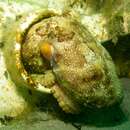Comprehensive Description
(
англиски
)
добавил Smithsonian Contributions to Zoology
Octopus pallidus Hoyle, 1885
DIAGNOSIS.—Animals medium-sized (to 540 mm TL; to 147 mm ML). Mantle broadly ovoid (MWI 67–78–91); head wide but narrower than mantle (HWI 44–58–89), demarked from mantle by moderate constriction; eyes large, not projecting far above surface of head. Funnel large, stout, bluntly tapered (FLI 31–39–52); funnel organ VV-shaped, limbs thick, outer limbs length of median limbs. Arms short (ALI 134–263), stout, tapering to fine tips. Arm lengths subequal, arm order usually IV > III > II > I. Suckers raised above arm surface, of moderate size (SI females 6–7–8, males 8–9–11), 10th to 13th suckers usually largest, enlarged on all arms of mature males. Right arm III of males hectocotylized, shorter than opposite arm (HAMI 156–184–219; OAI 79–82–89); ligula wide, medium-sized (LLI 9–11–16); ligula groove well marked and deep, with incomplete transverse ridges; calamus long, acutely pointed (CLI 32–40–55); hectocotylized arm with 72–86 suckers. Web moderately deep (WDI 24–30–41), web formula usually D > C > B > E > A. Radula with B4-5 asymmetrical seriation of rachidian. Ink sac present. Gill lamellae 7–9 per outer demibranch. Mature female with large eggs (capsule 11–13 mm long, 3–4 mm wide), attached singly to substrate by long, thin stalks. Penis long (PLI 13–19–27), with single-coiled diverticulum; spermatophores of medium length (SpLI 43–85–118), slender (SpWI 2.1–2.7–3.3), with large, coiled sperm reservoir (SpRI 35–43–52).
Integumental sculpture consists of pattern of coarse, uniformly “rosette”-shaped and closely set epidermal tubercles covering both dorsal and ventral surfaces. Tubercles largest on dorsum near base of arms, smaller and less prominent on ventral surface. Branched and unbranched papillae also present on dorsum. Papillae on mantle dorsum form ~5 subparallel rows of 4–6 simple, usually unbranched papillae along mantle length. Large arborescent papillae obvious in ocular region, with 4 supraocular and 2 subocular papillae. Three rows of 2 papillae each present on dorsal surface of web and dorsal pair of arms. Lateral integumentary ridge or fold around mantle circumference absent. In life, color of resting animals brown and cream mottled dorsally, paler ventrally; when stimulated, animals become uniformly dark brown to purple. Specimens preserved in ethyl alcohol reddish brown to orange dorsally, slightly paler ventrally. In both live and preserved specimens, faint orange stripe often present along length of dorsal arms. Surface of raised tubercles usually darker than background, giving reticulate pattern. Ocelli absent.
ORIGINAL DESCRIPTION.—Hoyle, 1885:223.
TYPE LOCALITY.—Australia, Victoria, off East Moncoeur Island (39°10.5′S, 146°37′E), 38 fm (70 m), sand and shell bottom.
TYPES.—Lectotype: BMNH 1889.4.24.19, 1 male, 56 mm ML. Specimen in good condition, preserved in ethyl alcohol.
Paralectotypes: BMNH 1889.4.24.20–21, 1 female, 78 mm ML, 1 juvenile. Specimens in good condition, preserved in ethyl alcohol.
DISTRIBUTION AND BIOLOGY.—Southeastern Australia, from the Great Australian Bight to central New South Wales, including Bass Strait and Tasmania. A species inhabiting the continental shelf and upper continental slope, living on sand or mud bottom, or among sponges and ascidians, at depths of 7–593 m.
The little information available on the biology of O. pallidus has been summarized in Stranks (1988b).
- библиографски навод
- Voss, N. A. and Sweeney, M. J. 1998. "Systematics and Biogeography of cephalopods. Volume II." Smithsonian Contributions to Zoology. 277-599. https://doi.org/10.5479/si.00810282.586.277
Octopus pallidus: Brief Summary
(
англиски
)
добавил wikipedia EN
Octopus pallidus, the pale octopus, is a species of octopus in Oceania.
Immediately after hatching, the pale octopus forages, primarily on bivalves. At night it hides in rubble to surprise prey. Female maturation is dependent on age as well as season. Both sexes can distinguish vertical from horizontal rectangles, and gradient greys from each other and uniform grey.
This species has been studied by scientists trying to determine octopus ages by stylets and pigment.
- лиценца
- cc-by-sa-3.0
- авторски права
- Wikipedia authors and editors

